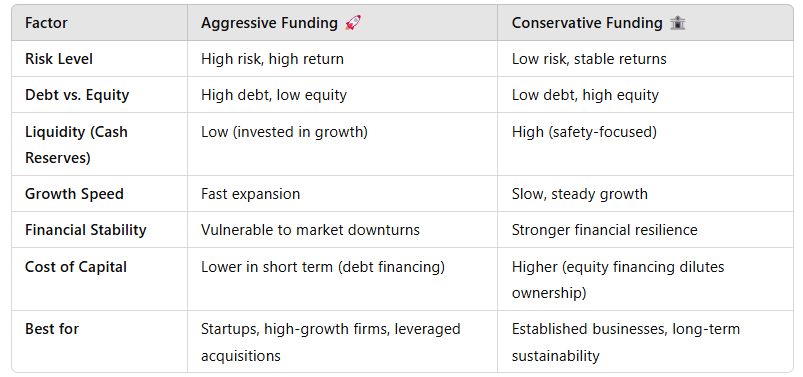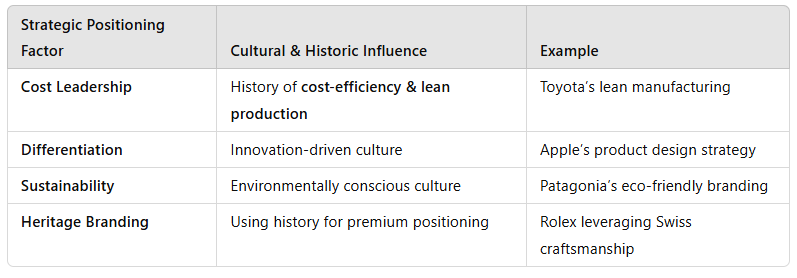CIPS L6M2 - Global Commercial Strategy
Compare and contrast an aggressive and conservative approach to business funding.
The Answer Is:
See the complete answer below in Explanation.
Explanation:
Comparison of Aggressive vs. Conservative Business Funding Approaches
Introduction
Businesses adopt differentfunding strategiesbased on theirrisk tolerance, growth objectives, and financial stability. Two contrasting approaches to business funding are:
Aggressive Funding Approach– Focuses onhigh-risk, high-reward strategieswithmore debt and short-term financingto fuel rapid expansion.
Conservative Funding Approach– Emphasizesfinancial stability, risk aversion, and long-term security, often relying onequity and retained earningsto fund operations.
Each approach has advantages and risks, influencing a company’sliquidity, cost of capital, and financial sustainability.
1. Aggressive Business Funding Approach🚀(High Risk, High Reward)
Definition
Anaggressive funding strategyinvolves maximizingshort-term debt, high leverage, and minimal cash reservestoaccelerate growth and expansion.
✅Key Characteristics:
Relies heavily on debt financing(bank loans, corporate bonds, short-term credit).
Prioritizes rapid growth and high returnsover financial security.
Uses minimal equity financingto avoid ownership dilution.
Maintains low cash reserves, assuming cash flows will cover liabilities.
💡Example:
Startups and tech firms (e.g., Tesla, Uber, Amazon in early years)oftenborrow aggressivelyto scale rapidly.
Private equity firmsfund acquisitions using high leverage to maximize returns.
Advantages of Aggressive Funding
✔Faster business expansion– Capital is readily available for investments.✔Higher return potential– More funds are allocated to revenue-generating activities.✔Lower equity dilution– Existing shareholders maintain control as funding is primarily debt-based.
Disadvantages of Aggressive Funding
âŒHigh financial risk– Heavy debt increases vulnerability to economic downturns.âŒLiquidity problems– Low cash reserves can cause issues during slow revenue periods.âŒHigher borrowing costs– Lenders charge higher interest due to the risk involved.
📌Best for:Fast-growing companies, high-risk industries, and businesses with predictable cash flows.
2. Conservative Business Funding ApproachðŸ¦(Low Risk, Long-Term Stability)
Definition
Aconservative funding strategyfocuses onlow debt levels, high liquidity, and long-term financingto ensurefinancial stability and steady growth.
✅Key Characteristics:
Uses retained earnings and equity financingover debt.
Minimizes reliance on short-term creditto avoid financial pressure.
Maintains high cash reservesfor financial security.
Focuses on steady, sustainable growthrather than rapid expansion.
💡Example:
Berkshire Hathaway (Warren Buffett’s company)follows aconservative funding model, relying on retained earnings rather than excessive debt.
Family-owned businessesoften prioritize financial stability over rapid expansion.
Advantages of Conservative Funding
✔Lower financial risk– Reduces dependence on external creditors.✔Stable cash flow– Ensures business continuity during economic downturns.✔Better credit rating– Stronger financial health allows for lower borrowing costs if needed.
Disadvantages of Conservative Funding
âŒSlower business growth– Limited access to capital can restrict expansion.âŒMissed market opportunities– Competitors with aggressive funding may outpace the company.âŒHigher cost of capital– Equity financing (selling shares) dilutes ownership and reduces profit per share.
📌Best for:Established businesses, risk-averse industries, and companies focusing on long-term sustainability.
3. Comparison Table: Aggressive vs. Conservative Funding Approaches
 A screenshot of a computer screen
Description automatically generated
A screenshot of a computer screen
Description automatically generated
Key Takeaway:The best funding approach depends onindustry, company stage, and risk appetite.
4. Which Approach Should a Business Use?
✅Aggressive Approach is Ideal For:
Startups & High-Growth Companies– Needfast capitalto capture market share.
Businesses in Competitive Markets– Companies that mustoutpace rivals through aggressive expansion.
Private Equity & Leveraged Buyouts– Maximizing returns throughhigh debt strategies.
✅Conservative Approach is Ideal For:
Mature & Stable Businesses– Companies prioritizingsteady revenue and financial security.
Family-Owned Enterprises– Owners preferlow debt and long-term growth.
Risk-Averse Industries– Businesses inessential goods/services sectorswherestability is more important than rapid expansion.
Hybrid Approach: The Best of Both Worlds?
📌Many businesses use a combination of both approaches, leveragingdebt for growth while maintaining financial stabilitythrough retained earnings and equity.
💡Example:
Appleused a conservative strategy in its early years but adoptedaggressive funding for global expansionpost-2010.
5. Conclusion
The choice betweenaggressive and conservative fundingdepends on a company’sgrowth goals, financial risk tolerance, and industry conditions.
✅Aggressive funding maximizes short-term growthbut increases financial risk.✅Conservative funding ensures stabilitybut limits expansion speed.✅Most companies use a hybrid modelto balancegrowth and financial security.
Understanding these approaches helps businessesoptimize capital structure, manage risk, and align financing with strategic objectives.
Explain how culture and historic influences can impact upon a business’s strategic decisions and positioning within the marketplace
The Answer Is:
See the complete answer below in Explanation.
Explanation:
How Culture and Historic Influences Impact Strategic Decisions and Market Positioning
A business’sstrategic decisionsandpositioning within the marketplaceare shaped by bothorganizational cultureandhistorical influences. These factors affect how a companydevelops strategy, interacts with customers, manages employees, and competes globally.
1. The Role of Organizational Culture in Strategic Decisions
Organizational culture is theshared values, beliefs, and behaviorswithin a company. It influencesdecision-making, innovation, and competitive advantage.
🔹How Culture Affects Strategy
✅Risk Appetite– A culture that embraces innovation (e.g., Google) will invest in R&D, while risk-averse cultures (e.g., traditional banks) focus on stability.✅Decision-Making Speed– Hierarchical cultures (e.g., Japanese firms) rely on consensus, while Western firms (e.g., Apple) may have centralized decision-making.✅Customer Engagement– Acustomer-centric culture(e.g., Amazon) leads to investment in personalization and AI-driven recommendations.
💡Example:
Toyota’s Kaizen Culture (Continuous Improvement)has shaped itslean manufacturing strategy, giving it a competitive advantage in cost efficiency.
2. How Historic Influences Shape Business Strategy
Historical events,past business performance, economic trends, and industry evolutionshape how businessesposition themselves in the marketplace.
🔹How History Affects Strategy
✅Legacy of Innovation or Conservatism– Companies with a history ofinnovation(e.g., IBM, Tesla) continuously push boundaries, while firms with traditional roots (e.g., British banks) focus on risk management.✅Economic Crises and Financial Stability– Businesses that survived financial crises (e.g., 2008 recession) tend to developrisk-averse financial strategies.✅Market Reputation and Consumer Perception– A stronghistorical reputationcan be leveraged for branding (e.g., Rolls-Royce’s luxury image).
💡Example:
Legonearly went bankrupt in the early 2000s, leading it toredefine its strategy, focus ondigital gaming partnerships, and revive its brand.
3. The Influence of National and Corporate Culture on Global Positioning
When expanding globally, businesses mustalign their strategies with different cultural expectations.
🔹How Culture Affects Global Market Entry
✅Consumer Preferences– Fast food chainsadapt menusfor local cultures (e.g., McDonald's in India offers vegetarian options).✅Negotiation & Communication Styles– Business negotiations inChinaemphasize relationships ("Guanxi"), whileWestern firmsprioritize efficiency.✅Leadership and Management Approaches–German firmsemphasize engineering precision, whileSilicon Valley firmsprioritize agility and experimentation.
💡Example:
IKEAmodifies store layouts in different countries—small apartments in Japan vs. large home spaces in the U.S.
4. Strategic Positioning Based on Cultural & Historic Factors
A company’s historical and cultural influences define itspositioning strategy:
 A screenshot of a white box
Description automatically generated
A screenshot of a white box
Description automatically generated
Conclusion
A business’sstrategic decisions and market positioningare deeply influenced byorganizational culture, national culture, and historical performance. Companies thatleverage their cultural strengths and adapt to market historycan achievelong-term competitive advantage.



